I doubt many of us think about rhythm when constructing a melody or lyric - apart from setting a time signature and tempo. That is, we create the rhythms that feel most natural, those that more or less flow out of your head or mouth automatically with the lyrics, and rarely sit down and chart out the actual beat placement within each bar. However, analyzing a few examples and trying this on your material may give you insight into unique characteristics of your own writings, whether you use the same rhythms from song to song, where there are flaws, and hopefully inspire new ideas for creating an interesting melody.
Here are some examples that are fairly simple (p.s. I'm not notating melody here, so you can concentrate on the rhythm!):

(Blowing in the Wind - Bob Dylan)
We can easily change the feel of this classic tune by rewriting the rhythm. For example:

Here's another one:

(Eight Days a Week - John Lennon and Paul McCartney)
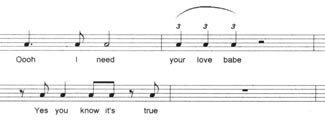
Better? I doubt it. But different.
Now here's a slightly more "unstandard" example with a syncopated structure...

(Conga - Gloria Estefan)
This type of syncopation is found more in certain genres of music than others - you won't often find it a country song.
A Canadian classic with triplets:
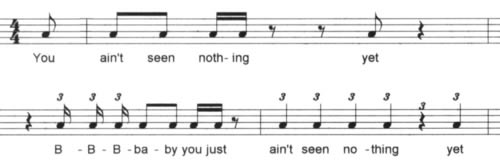
(You Ain't Seen Nothing Yet - Randy Bachman)
Here's a few simple exercises to get you thinking about rhythm.
Sing random one-syllable words like these, with each syllable getting one beat...
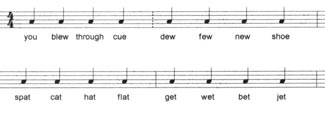
...then slurring like this (singing between two different pitches will make it easier to hear the rhythm)
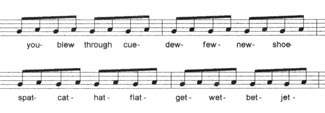
You'll notice that the first line consists of words ending in vowel sounds, while the second line ends with consonants. Which one is easier to sing? Since we can't sustain consonant sounds, it's where the vowel(s) and syllables fall within lyrics that determine where the pitch of the melody can be sustained or changed comfortably.
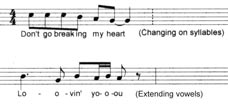
So what's the point, you say? You should be aware of beat placement when writing melodies because a common problem - often in young writers and/or those who haven't had their songs performed by others - is an odd number of beats in a phrase, an odd number of bars in a section (i.e. verse), and so on. This is not a problem if it's been done intentionally or you are aware of it. (For example, adding a bar of 2/4 at the end of a certain section for effect.)
When it's unintentional, however, you may end up playing the song inconsistently (7 bars in the chorus one time, 8 the next), which leads to confusion in the feel, and headaches for anyone besides you who is trying to learn the song (session players, band mates, etc.)! Or, it could sound "off" to anyone listening.
Often this odd-timing situation will pop up when your lyrics, as originally written, do not quite fit into the time signature of the song, and as a result you have to tack on another beat or another measure. You may not even realize that you've done it. Again, if this is the feel you want, great! It's okay to flip between time signatures if that's what you hear in your head - just make sure that it's consistent from performance to performance. But maybe that's not the feel you want, and a quick change to the rhythmic phrasing of the lyric will better maintain the groove of the song.
Here's a second exercise. Notice how the syllabic pattern suggests the rhythm:
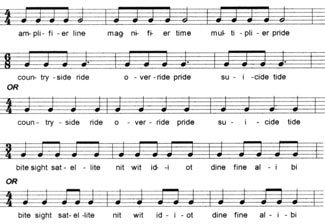
Also watch for words that sound a little like two syllables when sung, but are really one. For example, wire (why-er), tire (ty-er), fire (fy-er). And two that sound like three, i.e. acquire (ak-why-er). They can be quite awkward to sing, and they may throw your phrases off track.
The rhythmic structure of the lyric also, in part, determines the tempo of a song. Choosing the tempo will be very important - if it's off, the groove you have set up with your lyrics will not work. (P.S. You do own a metronome, don't you?)
Try to imagine the breakneck-speed "Conga" (earlier example) sung at a slow pace. The effect of the syncopation would be lost. It's not as simple as "playing the song slow enough that the singer can fit all the words in." In some cases you'll want to present a uniquely phrased song in a way that gives the vocalist lots of room to soar, while in some cases you'll want to complement a staccato vocal phrasing with a rapid-fire tempo.
It's important to understand how the vocal rhythm will affect the way the song is presented - because if you're forcing the vocalist to sing too many syllables rapidly, or writing a melody that accents the wrong syllables (or words), it will not feel natural to sing the song.
Let's look at the Bob Dylan number again. It's written in 4/4, which means we naturally hear the main accent on beat 1, and a weaker one on beat 3. (Read this aloud, stressing the bold words.)
How many roads must a man walk down
Before you call him a man?
See how the accents fall on the key words? Even when we rewrote it, the primary words didn't shift much:
How many roads must a man walk down
Before you call him a man?
What if you stressed it like this...
How many roads must a man walk down
Before you call him a man?
Do you pay attention to the style of vocal rhythm people employ when carrying on normal conversations? I often find that people speak at "one word per beat", and automatically adjust each word so that they fit regardless of the syllables. For example, if you read this sentence aloud...
It was a dark and stormy night; the clouds hung low and the rainswept cliffs were beckoning her to flee to the warmth of the stables.
...you'll probably find that the words stormy and rainswept become eighth notes and beckoning becomes a triplet.
Which words are accented when you speak - or sing - is also extremely important. "Tone of voice", or which words you place emphasis on, is responsible for more misunderstandings and arguments than anything else (according to a book I just read...) For example, a simple question like "Is it alright if I go to my room now?" can become
Is it alright if I go to my room now?
Is it alright if I go to my room now?
Is it alright if I go to my room now?
The placement of accents is equally important in your songs. You'll probably want the key words to be accented, especially in hook sections.
By listening to the rhythmic patterns of people when they're simply speaking you'll find it easier to write natural-feeling vocal rhythms for your songs. If you don't own a metronome, buy one! Turn it on and play all your songs with it. You'll know pretty quickly whether you've got a rhythmic glitch in your lyric. The most important thing is knowing it's there and/or being aware of what's going on in your song. Whether you like it and want to leave it in, or want to change it - that's up to you!







